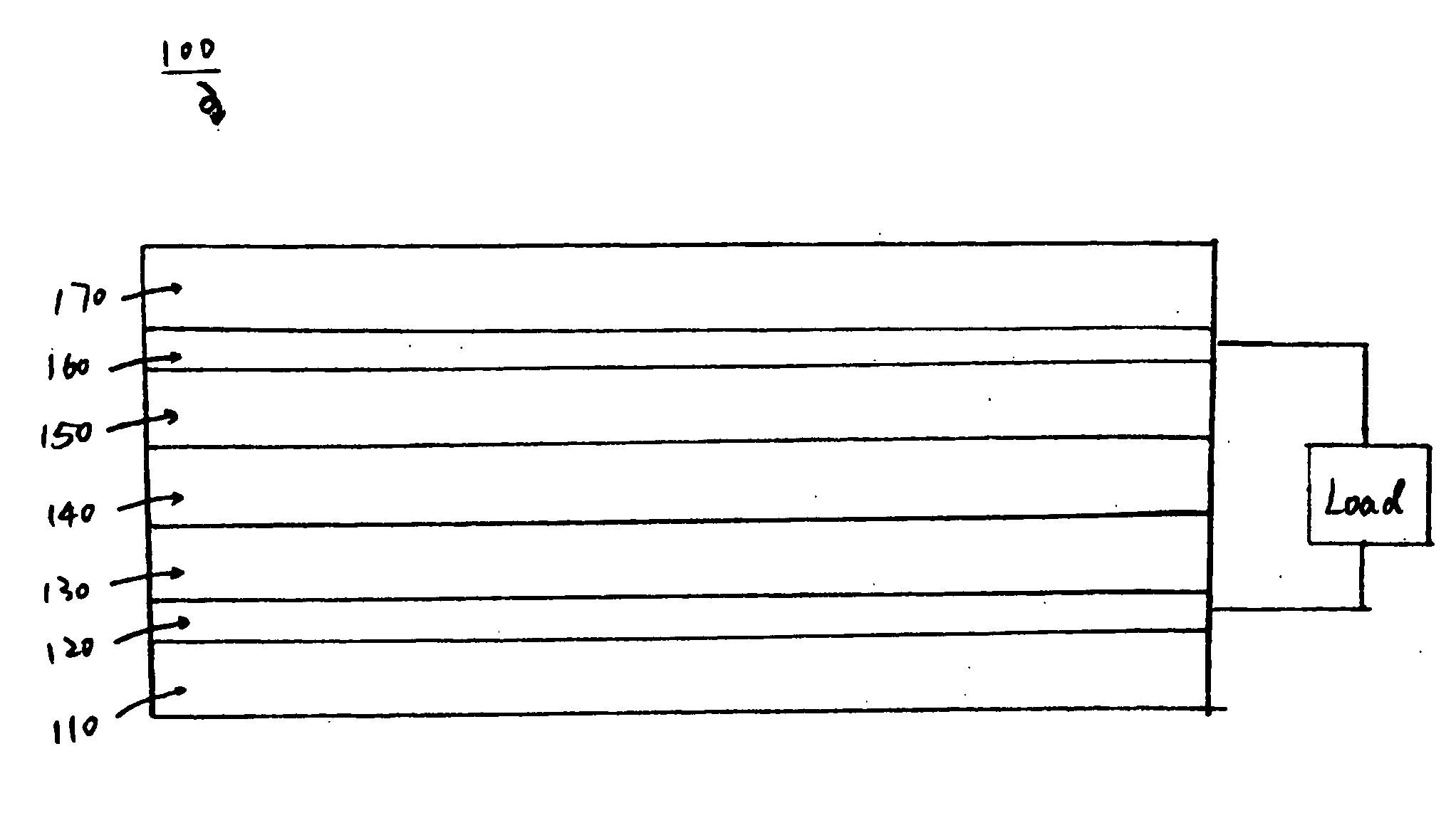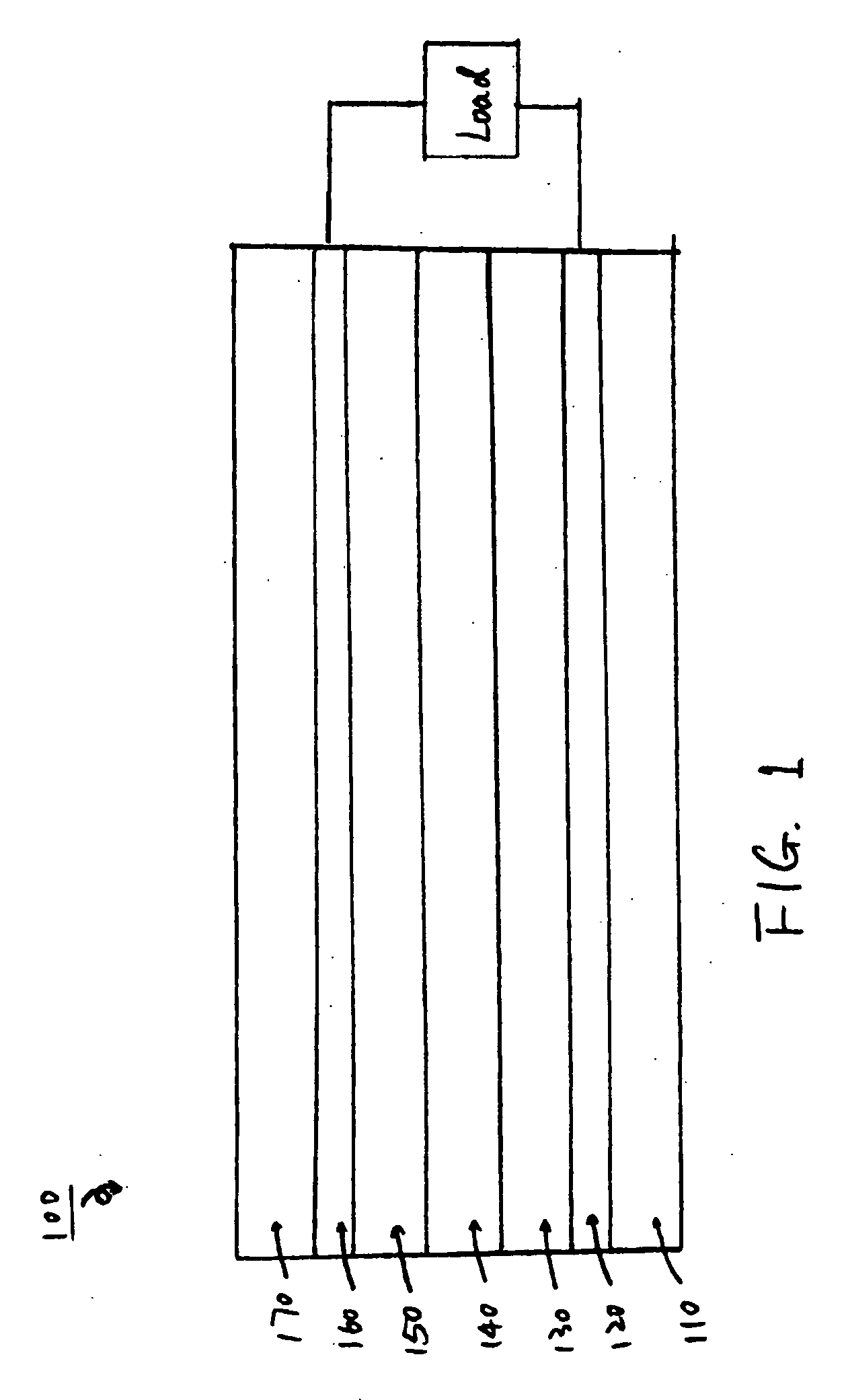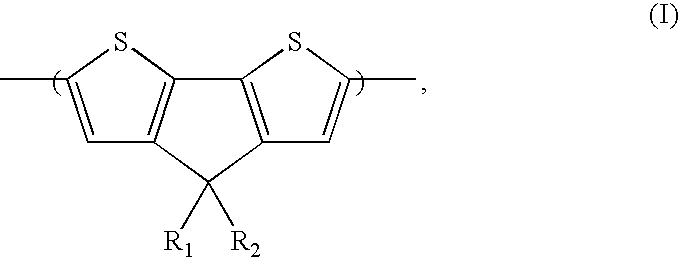Polymers with low band gaps and high charge mobility
- Summary
- Abstract
- Description
- Claims
- Application Information
AI Technical Summary
Benefits of technology
Problems solved by technology
Method used
Image
Examples
example 1
Synthesis of 4,4-Dihexyl-4H-cyclopenta[2,1-b;3,4-b′]dithiophene
[0043]
[0044] 4H-Cyclopenta[2,1-b;3,4-b′]dithiophene was synthesized according to literature procedure illustrated in Coppo P., Cupertino, D. C., Yeates S. G., and Turner, M. L. Macromolecules 2003, 36, 2705-2711. All other starting materials were purchased from Sigma-Aldrich and used as received.
[0045] 4H-Cyclopenta[2,1-b;3,4-b′]dithiophene (1.5 g, 0.00843 mol) was dissolved in DMSO (50 mL). The solution was purged with nitrogen, and grounded KOH (1.89 g, 0.0337 mol) and sodium iodide (50 mg) were added, followed by hexyl bromide (3.02 g, 0.0169 mol). The reaction was stirred for 17 h under nitrogen at room temperature. Water was added and the reaction was extracted with t-butyl-methyl ether. The organic layer was separated and dried over magnesium sulfate. Solvent was removed under vacuum and the residue was purified by chromatography using hexanes as eluent. Fractions containing pure 4,4-dixeyl-4H-cyclopenta[2,1-b;3,...
example 2
The Synthesis of 4,4-Dihexyl-2,6-bis-trimethylstannanyl-4H-cyclopenta[2,1-b;3,4-b′]dithiophene
[0046]
[0047] Starting material 4,4-dihexyl-4H-cyclopenta[2,1-b;3,4-b′]dithiophene (1.5 g, 0.00433 mol) was dissolved in dry THF (30 mL). The solution was cooled to −78° C. and butyl lithium (6.1 mL, 0.0130 mol) was added drop wise. The reaction was stirred at this temperature for 2 h and warmed to room temperature, stirred for 3 h. Again reaction was cooled to −78° C. and trimethyltin chloride (1 M in hexanes, 16.0 mL, 16.0 mmol) was added dropwise. The reaction was allowed to warm to rt and stirred for 17 h. Water was added and the reaction was extracted with toluene. The organic layer was washed with water and dried over sodium sulfate. Solvent was removed under vacuum and the residue was dissolved in toluene, and quickly passed through a plug of silica gel pretreated with triethyl amine. Solvent was removed and the residue dried under vacuum to afford 2.65 g of the bis(trimethyltin) mon...
example 3
The Synthesis of bis-(tributylstannyl)-4,4-dihexyl-cyclopenta[2,1-b:3,4-b′]dithiophene
[0048]
[0049] 4,4-Dihexyl-4H-cyclopenta[2,1-b;3,4-b′]dithiophene (2.2 g, 0.0065 mol) was dissolved in dry THF (20 mL). The solution was cooled to −78° C. BuLi (7.62, 2.5 M in hexanes, 0.019 mol) was then added to the solution. The reaction mixture was allowed to warm to room temperature and was stirred for 5 hours. The mixture was then cooled again to −78° C. and Bu3SnCl (7.44 g, 0.0229 mol) was added. The reaction mixture was allowed to warm to room temperature and was stirred for another 48 hours. Water was then added and the mixture was extracted with dihicholomethane. Organic layer was collected, dried over anhydrous Na2SO4, and concentrated. The residue thus obtained was dissolved in hexane and quickly passed through a plug of silica gel pretreated with triethylamine. The solvent was removed and the residue was dried under vacuum to afford bis-(tributylstannyl)-4,4-dihexyl-cyclopenta[2,1-b: 3,...
PUM
| Property | Measurement | Unit |
|---|---|---|
| Energy level | aaaaa | aaaaa |
Abstract
Description
Claims
Application Information
 Login to View More
Login to View More - R&D
- Intellectual Property
- Life Sciences
- Materials
- Tech Scout
- Unparalleled Data Quality
- Higher Quality Content
- 60% Fewer Hallucinations
Browse by: Latest US Patents, China's latest patents, Technical Efficacy Thesaurus, Application Domain, Technology Topic, Popular Technical Reports.
© 2025 PatSnap. All rights reserved.Legal|Privacy policy|Modern Slavery Act Transparency Statement|Sitemap|About US| Contact US: help@patsnap.com



